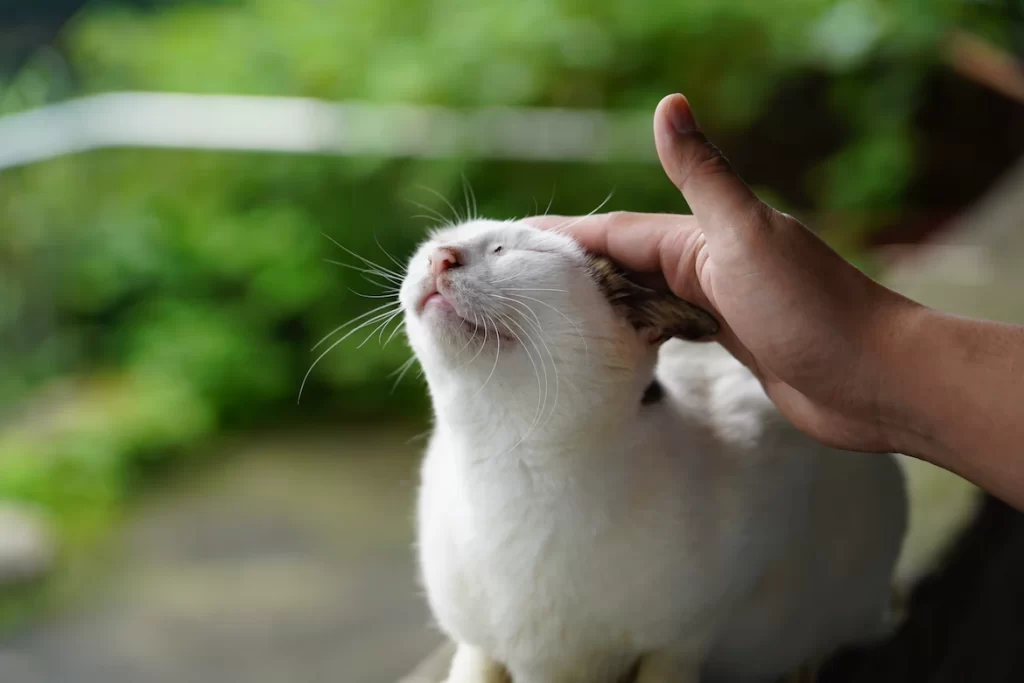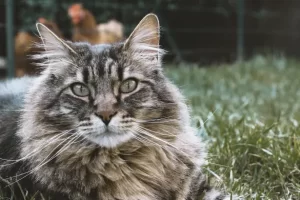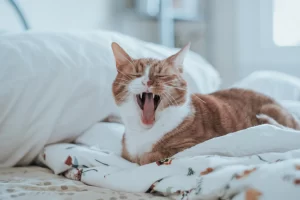Last updated on February 12th, 2023 at 02:19 am

Life can rapidly become monotonous. What once excited you can swiftly become obsolete. Cats are no exception. Toys and games are fun when they are new, but after a while, your cat will become bored with them. If this describes your cat, a massage might be just what she needs. But how to give your cat a massage?
Most owners massage their cats to make them feel more relaxed, less anxious after a stressful incident, and simply more loved and cared for. In fact, if done correctly, massaging your cat can make him feel a lot better than merely being petted. Try this bonding approach when your cat needs a pick-me-up or when you wish to connect with your cuddly companion. You might be shocked to learn that cats, like humans, can benefit from massages. A decent massage can help relax stressed-out kittens while also strengthen your bond. You’ve come to the correct place if you want to learn how to connect with your cat while also enabling it to relax.

Tilcare Handheld Pet Massager for Dogs and Cats
How to Give Your Cat a Massage?
Giving your cat a massage is an excellent way to express your love and affection. It can also benefit their health by relaxing muscles and lowering stress levels. Here’s how to massage your cat.
Put Yourself in the Right Frame of Mind
Nobody wants to be massaged by someone who is furious or in a hurry. The masseuse will be preoccupied with their own feelings and ideas and will not provide their whole attention to making you feel better. This is also true when massaging your cat.
Do not begin a massage if you are rushed, frustrated, stressed, or furious. Allow yourself some time to relax and put your outside issues aside for a few minutes.
You do not have to massage your cat for 60 minutes for it to benefit from your touch. A few minutes of well-intentioned massage may do wonders for your kitten, so make sure you’re in the right frame of mind.
File and Trim your Nails
It is essential to prepare for this activity, just as it is for any other. First and foremost, ensure sure your fingernails are properly trimmed. Any rough or jagged edge can irritate the animal.
Furthermore, if you have long nails, you will be unable to fully utilize the finger pads when exerting pressure. We only use our finger pads to massage cats on particular portions of their bodies, such as their heads and faces. As a result, it is best to cut and file the nails to avoid injuring or discomforting the pet.
Keep Track of the Appropriate Time
We do not give massages randomly or whenever we feel like it. The operation must be started at the appropriate time.
Most cat owners wait for their animals to approach them. This is frequently a sign that the cat is ready for some snuggle time. It indicates that the cat is particularly receptive to your caresses or gentle rubbing. This is the ideal time to begin massaging the cat for obvious reasons.
However, because some feline breeds are more independent than others, the cat may refuse to come to you. In such instances, it is better to wait until the cat is relaxed before beginning the massage.
For example, if you notice it grooming itself, it is a good idea to wait until it is finished. It is also vital to give your cat a massage at least 2 hours after the cat’s last meal. Massage right after a meal may increase the risk of regurgitation or vomiting. Furthermore, because the cat will be lying down, there is a risk of aspiration. Two hours is enough time for the cat’s food to break down in its stomach and begin its journey in the small intestines.
Prepare Your Cat for the Massage
It is also vital to examine your mood before beginning the massage. Cats have an extraordinary capacity to interpret human emotions and “sense” them. They will not come to you for a massage if they detect that you are apprehensive or stressed. Take several deep breaths if you’re having trouble relaxing. This will boost oxygen delivery to the brain and increase the release of mood-regulating neurohormones.
Approach the cat and speak to it softly, gently, and cheerfully. The idea is that you set the tone for the massage. It should be relaxing and soothing. Talking to your pet in a calm but cheerful tone relaxes the animal.
It might also want to cuddle up to you. If this occurs, there is no need to pick up your cat. Never use the high-pitched voice that most people do to chat with their cats. High-pitched, squeaky voices might be stressful for your cat.
When your kitty is snuggled up to you, caress the animal with your entire hand. Begin with your cat’s favorite area. For example, if the feline’s favorite spot is behind its ears, begin there. Caress its tummy if it’s on its stomach. The crucial thing here is to begin caressing the cat in a familiar location. This will make the animal more receptive to the massage. You can also choose to do the massage with your hand manually or use a massager that can easily be bought online.
Best Pet Massager: Tilcare Handheld Pet Massager for Dogs and Cats

Give your cat a massage treatment and bond with them to help them relax. This pet massager delivers a deep-tissue massage that alleviates aches and pains, joint stiffness, and inflammation. Therapeutic massage improves your pet’s mobility and agility by increasing circulation and relieving tight muscles and arthritis. This therapeutic pet massager comes with four massage heads and 96 kneading nodes made of soft silicone that is gentle on the skin and fur. Choose one of two intensity levels for each pet massage session.
This body and head massager is small enough to fit in the palm of your hand and comes with a long-lasting, rechargeable battery. The IPX6 water-resistant dog and cat head massager is ideal for loosening dirt and grime while cleaning your pet. This pet massager relieves arthritis in the hips and improves mobility and agility by reducing stiffness and discomfort in the joints. This soothing massager also functions as a back scratcher, reducing stress and anxiety.
Pros:
- Waterproof and Rechargeable
- Easy to use and very light.
Cons:
- Long Charging Time.
Observe your Cat’s Reaction
While you give your cat a massage, keep a watch on its reaction. If your cat continues to try to stand, he might not be in the mood for a massage. If they are blinking, purring, drooling, nodding out, or appearing bewildered, they are most likely enjoying the massage.
If your cat begins to scratch you or backs up, stop rubbing it. You can try it again in a few hours or days because it’s most likely not personal. Some cats may elevate their butts when receiving a massage, especially if you’re stroking them down their spine from the top of their head to the base of their tail.
When Massaging a Cat, Keep These Things in Mind:
- You must respect your cat. If you sense any type of resistance throughout the massage session, don’t push it. Stop the massage and schedule another one. You don’t want your cat to develop negative feelings about you or the massage.
- Be aware that the cat’s skin is extremely sensitive. That is why you should only use light pressure.
- Take advantage of the massage session to examine the animal’s coat and skin. Check for and record any abnormalities.
- Every day, cats should be massaged for no more than 5 to 10 minutes.
It is simple to give your cat a massage. The idea here is to only begin the massage when the cat is relaxed and peaceful. Using only light pressure is also beneficial.
How to Massage Your Cat’s Head and Neck?
Massage the cat’s face on both sides. This is an area noted for releasing mood-calming pheromones. When you observe cats interact, you will notice that they frequently rub the sides of their faces against one another. It soothes them. Caressing this area will help make your cat feel relaxed and tranquil.
- Move your palm in a circular manner over the cat’s head. Massage the top of its head with soft pressure. Make your way to the temples and the back of your head. Massage the area behind and around the ears in a circular motion with your fingertips as you make your way around.
- Using the tips of your fingers, massage the forehead and cheeks in a circular manner. Apply mild pressure to the sides of the cat’s face with your palms. Examine whether your cat enjoys the massage. If this is the case, it may close its eyes or purr in approval. This is your cue to start rubbing the region surrounding the cat’s eyes, nose, and whiskers.
- Begin stroking the animal’s neck slowly and deliberately. Be extremely delicate. Apply moderate pressure to the cat’s neck using only your finger pads. Massage the full length of the neck with small circular movements. Do not force your fingers into the cat’s neck.
Your cat will appreciate you giving them a nice head massage. It’s also a wonderful method to express your affection and strengthen your bond with your pet. So, why not give it a shot?
How Do You Massage The Body?
After you’ve finished massaging the cat’s head and neck, you can move on to the rest of its body. Massage its body from the base of its neck to the base of its tail. To relax your feline companion, use long, gentle strokes.
- Rub the animal’s shoulders in tiny circles with your fingertips. Take note of the shoulder joints. Put your hands on both sides of the cat’s body and massage them together. Knead the sides together gently yet firmly. This will aid in the relaxation of any tense muscles in the body.
- Stroke the back and sides of the animal. Apply light pressure while moving your hands in small circles. Concentrate on the animal’s upper back because most cats are highly sensitive in the hips and lower back. However, if your pet enjoys being petted or stroked in this region, proceed with caution.
- Make your way to the cat’s tummy. Some cats are so comfortable that they would rest on their backs with their bellies exposed. Knead it gently and slowly on its belly. You can also massage the cat’s belly while stroking the sides of its head with the other hand. This will make the animal more receptive to a belly massage.
You might as well massage its chest while you’re already massaging the underside of its body.
How to Perform a Tail and Limbs Massage?
You have two alternatives after massaging your cat’s body. You can start with the limbs and paws and work your way to the tail, or you can start with the limbs and paws and work your way to the tail. In any case, make sure to massage certain areas of the cat’s body as well. What you need to know is that the cat’s tail is one of the most sensitive regions of its body. As a result, it is best to massage it last.
Massage the limbs by stroking your palms over the entire length. Circular motions should be used from the base of each leg to the paws. Once you’ve reached the paw, use your thumb to gently press the center of each paw pad. Circular motion with the thumb. Finish the treatment by massaging the tail. Begin at the bottom and work your way up to the tip. Because the tail might be very sensitive, only use very mild pressure. If you apply too much pressure, the cat may bolt up and out of the massage session. Tailbone massages can assist your cat’s body to relax and relieve stress. They may also aid in the improvement of blood circulation and the promotion of healing.
Your cat may feel tired or relaxed after receiving a massage. Allow your cat the time it requires to recover from the session. By creating a peaceful, calm environment, you can assist your cat in relaxing and recovering. Provide your cat with a soft bed or blanket to snuggle in. After the massage, you may wish to give your cat a light supper or treat. This will aid in replenishing any energy consumed during the session.
Arthritis and Cat Massage
Arthritis is a joint condition characterized by joint inflammation. The condition can be frightening to a cat, causing excruciating agony. Unfortunately, there is no cure for arthritis.
The only method to help an arthritis-affected cat is to alleviate her signs and symptoms, notably discomfort. Your veterinarian may prescribe pain relievers, but these may not always be effective. You also don’t want your cat to become overly dependent on medication for the remainder of her life. Massage is one of the alternate methods you can use to help your cat. A gentle touch on the joints may be all your cat needs to feel better.
How Should You Massage Your Arthritic Cat?
- Make sure you and your cat are both in the mood for the massage. If your cat becomes angry after a painful event, it may not be the greatest time to rub her.
- Place your cat on a soft surface, such as your lap.
- Begin rubbing her legs, concentrating on the joints and surrounding areas.
- Begin slowly with slow circular motions.
- Your cat should remain calm throughout. Reduce the pressure or take a pause if you notice her flinching or withdrawing.
- Repeat the procedure as often as your cat desires.
Your cat should ideally be massaged by a professional, but you can also learn from a skilled expert or vet to avoid injuring your cat. Always consult your veterinarian before beginning any sort of therapy, including massage, for arthritic cats.
Is There Ever a Time When I Shouldn’t Massage My Cat?
You should not give your cat a massage in regions where there are open wounds or unstable fractures. You should avoid massaging your pet if they are in significant pain that is not yet under control. Massage directly on top of regions where your cat may have infections or tumors. Vets also advise caution while massaging cats that have blood clotting disorders.
Conclusion
Cats, like humans, deserve massages. Whether she is well or sick, your cat will enjoy the sensation of you or a masseuse softly stroking her body over and over. Massages can help your cat by improving blood circulation, reducing anxiety, relieving pain, speeding up healing after an injury, and reducing stress. Remember that cats enjoy being stroked and petted, so don’t be afraid to express your love for your cat with a devoted session of massage therapy.
If your cat is sick, you should consult with your veterinarian before using any massage treatments. They can advise you on which massage techniques will be most effective for your cat’s individual condition.


